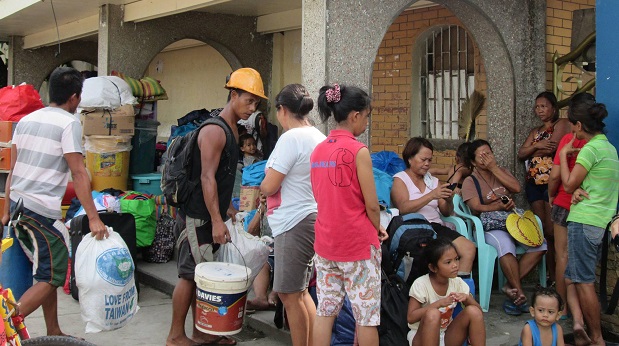
Residents arrive at an evacuation center in Tacloban city, Leyte province, central Philippines Thursday, Dec. 4, 2014, as they prepare for approaching Typhoon Hagupit. Villagers fled coastal homes and sparked panic-buying in grocery stores and gas stations in the central Philippines on Thursday as an approaching powerful storm brought back nightmares of last year’s deadly onslaught from Typhoon Haiyan. AP
MANILA, Philippines — A wide swath of the Philippines, including the capital Manila, braced Friday for a dangerously erratic and powerful typhoon approaching from the Pacific, about a year after the country was lashed by Supertyphoon “Yolanda” (international name: Haiyan) that left more than 7,300 people dead.
Typhoon Ruby (international name: Hagupit, Filipino word for lash) strengthened overnight with its sustained winds intensifying to 215 kilometers (134 miles) per hour and gusts of 250 kph (155 mph). The local weather agency Philippine Atmospheric, Geophysical and Astronomical Services Administration’s forecasts show the typhoon may hit Eastern Samar province late Saturday or early Sunday.
But a forecast by the US military’s Joint Typhoon Warning Center in Hawaii said Ruby may veer northward after making landfall and possibly threaten Manila, which has population of more than 12 million people.
“We have alerted the people of Manila and we’re ready,” Mayor Joseph Estrada said, while acknowledging “these typhoons change direction all the time.”
It is currently 450 kilometers (280 miles) from the country’s eastern coast in the Pacific Ocean and moving slowly.
If the first forecast holds, Ruby’s path will send it barreling inland into central Philippines along the same route where Yolanda leveled villages and left more than 7,300 dead and missing in November last year.
Still, Ruby’s erratic behavior prompted the government to call an emergency meeting of mayors of Metro Manila to warn them to prepare. Manila is north of the path that Yolanda took.
Given the country’s experience with Yolanda, which caught people unprepared to deal with its ferocity, authorities seemed better positioned this time to respond to the impending crisis.
Officials in central Philippine regions, which were hammered by Yolanda, evacuated thousands of people to safer areas, including Tacloban city, where the new typhoon has triggered panic-buying in grocery stores and gas stations and brought back nightmares of last year’s deadly onslaught.
Yolanda survivor Emily Sagales said many of her still-edgy neighbors in Tacloban packed their clothes and fled to a sports stadium and safer homes of relatives. Long lines formed at grocery stores and gas stations as residents stocked up on basic goods, she said.
Yolanda demolished about 1 million houses and displaced some 4 million people in the central Philippines. Hundreds of residents still living in tents in Tacloban have been prioritized in an ongoing evacuation.
Hotels in Tacloban, a city of more than 200,000 people still struggling to recover from last year’s massive damage, ran out of rooms as wealthier families booked ahead for the weekend.
The government put the military on full alert, workers opened evacuation centers and transported food packs, medicines and body bags to far-flung villages, which could be cut off by heavy rains.
In Manila, President Benigno Aquino III on Thursday led an emergency meeting of disaster-response agencies and ordered steps to prevent panic-buying and hoarding of goods.
The government decided to move the venue of a meeting next week of the Asia-Pacific Economic Cooperation forum, which was to be attended by hundreds of diplomats from 21 member economies, from Albay province, which could be lashed by the typhoon, to the capital, Manila, which forecasters said on Thursday will likely be spared.
RELATED STORIES
‘Ruby’ to bring rains in Metro Manila
‘Ruby’ maintains strength; Signal No. 2 up in 11 areas

